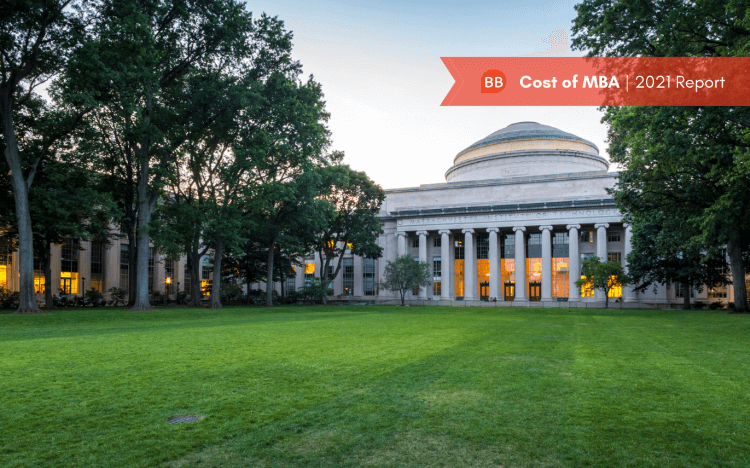The average total cost of pursuing a full-time MBA at a top-ranked business school has grown from $168k in 2020 to $176k in 2021.
The cost of an MBA is growing more rapidly outside the United States, with the average total cost of an MBA in Asia growing by 10%, and in Europe by 9.7%, between 2020 and 2021, although US MBA programs remain the most expensive.
An MBA in the USA will set you back over $217k in terms of total estimated cost, compared with $130k in Europe, and $108k in Asia.
“A big driver of that overall cost is the cost of tuition. While some schools froze their MBA tuition fees in 2021, others were forced to increase tuition as revenues suffered elsewhere,” says Marco De Novellis, senior editor of BusinessBecause.
Download our Cost of MBA Report 2021
Cost of MBA Report 2021 | Key findings
The annual BusinessBecause Cost of MBA Report, released in partnership with MBA loans company Juno in 2021, breaks down the total cost of MBA programs at the world’s top business schools, covering MBA tuition fees as well as living costs, healthcare, extra fees, and the cost of books and materials.
According to our report:
- MIT Sloan remains the world’s most expensive MBA, with a total cost of $241,984, up by 1.8% compared with 2020.
- NUS Business School offers the most affordable top-ranked MBA, with a total cost of $89,342.
- The total cost of the MBA at HEC Paris increased the most between 2020 and 2021 (by 16.3%), followed by Oxford Saïd (15.6%), and Cambridge Judge (15%).
- Only Virginia Darden saw a decrease in the total cost of its MBA in 2021, down 3.6%.
Why is the cost of an MBA increasing?
Rising tuition fees as well as a less favorable exchange rate against the dollar for non-US schools are the main drivers for the overall MBA cost increase. When calculating cost, we convert all local currency into US$.
The cost of MBA tuition increased by 7.6% on average globally in 2021, with the most significant fee increases made by London Business School and HEC Paris.
HEC Paris increased its tuition fees from €72,500 (September intake) and €69,620 (January intake) to €78,000 and €76,000 respectively.
Business schools that increased their tuition fees in the past year did so in the context of the coronavirus pandemic.
As companies cut spending, schools lost revenue from executive education in the past year while they also increased their spending to enable virtual teaching. For some schools, increasing MBA tuition fees is a way to recover from the financial impact of COVID-19.
“MBA programs have tried to do everything they can to try to keep fees affordable—Harvard dispersed another $6 million in financial aid in the past year—but some schools are hurting financially due to COVID,” says David White of MBA admissions consulting firm Menlo Coaching.
Although demand for MBA programs has boomed during the pandemic, that’s unlikely to have influenced schools’ decision to increase fees, according to David.
“There’s no Uber surge pricing for business schools!” he says. “Schools are inherently long-term focused and much of their budget, in the US in particular, comes from contributions from alumni.
“They know that if they charged you 20% more in tuition, you’re not going to donate money back to the school later on.”
In fact, several top US business schools froze tuition fees in 2021—including Harvard, Stanford, and Darden—while Yale was the only school to reduce tuition, according to our report.
Esade Business School in Spain also froze tuition fees in reaction to COVID, says Cristina Olabarría, recruitment and admissions director at Esade.
“Our main objective is to continue strengthening our scholarship fund and the financial aid portfolio that we offer to Esade candidates, so the pandemic isn’t an impediment for talented people to be able to study at Esade regardless of their financial situation,” she says.
INSEAD only made a minor increase to its tuition fees of around $1,000. Katy Montgomery, INSEAD’s associate dean of degree programs, says the school kept tuition fairly flat to account for students coming from all over the world, including countries hardest hit by COVID-19.
“Diversity in the classroom is our number one priority and we felt keeping the tuition constant would better enable us to maintain 92 countries represented in our MBA program,” she says.
While the cost of an MBA has increased the most at European business schools, the total cost of a top-ranked MBA in Europe is still relatively low at most schools compared with the US.
MIT Sloan is the world’s most expensive MBA program in terms of overall cost, at close to $242k, followed by NYU Stern and Stanford.
Funding your MBA
While MBAs are expensive, you shouldn’t let the cost of an MBA put you off applying to business school.
“MBA students transform their careers after graduation; start exciting new businesses, land the best jobs, and see their salaries skyrocket. Plus, business schools offer generous scholarships and funding options,” says Marco.
One option for US MBA students is Juno, which uses group buying power to negotiate the best student loan rates possible for MBA participants.
Juno has helped MBA students get more than $300 million in education loans and make savings of up to $15,000 on loan repayments.
Ryan Price, star of the BusinessBecause MBA Newcomer series, who starts his full-time MBA at BYU Marriott School of Business in the fall, says lenders compete for the business of Juno’s large client pool of MBA students.
“Yes, it’s still a student loan that will need to be paid back, but it’s the cheapest option in terms of interest that I could find anywhere for US schools,” he says.
Download our BusinessBecause Cost of MBA Report
RECAPTHA :
2d
1b
16
ba









